What’s a DASYRAC then?
DASYRAC is my voltage-controlled Eurorack modular synthesiser. It’s a synthesiser because it creates positive and negative voltages which turn into vaguely musical positive and negative sound waves when they’re sent through a speaker coil. It’s modular because it’s built up from modules and instruments which each have a specific role to perform in the process of synthesis. It’s Eurorack because the modules use Doepfer’s Eurorack specfications for size (3U) and voltage (+/- 12V & +5V supply rails, plus gate and pitch CV buses which only Doepfer’s modules seem to use).
Finally, it’s voltage-controlled because the modules are connected by patch cable and signal one another using voltages. Signal types include:
- triggers – a very short pip of steady positive voltage used trigger a modulation source or function generator, reset a sequence, etc
- clocks – a series of short triggers used for timing, usually evenly spaced
- gates – a sustained steady positive voltage which is held “high” for the length of a note or other event
- modulation – a non-steady voltage which is used to control module functions
- pitch – a voltage which is used to represent the pitch of a note, where one volt corresponds to one octave (1v/oc); usually steady, but not always
- audio – a varying voltage which rapidly swings positive and negative and is intended to be heard at some point
Because they’re all made of the same stuff (flowing electrons), these signals can play one another’s roles – audio and gate signals can both be a modulation source, sufficiently fast clocks can be an audio source, audio can also be a clock source, pitch can be a modulation source, modulation can be a pitch source, and triggers can even be an audio source as long as you’re into snaps and clicks. Part of the fun of modular synthesisers is just seeing what happens when you connect modules together in unconventional ways.
Here’s a recent photo of a cable-free DASYRAC with colour-coding to show what the different modules do. If a module has more than one function, it gets more than one colour.
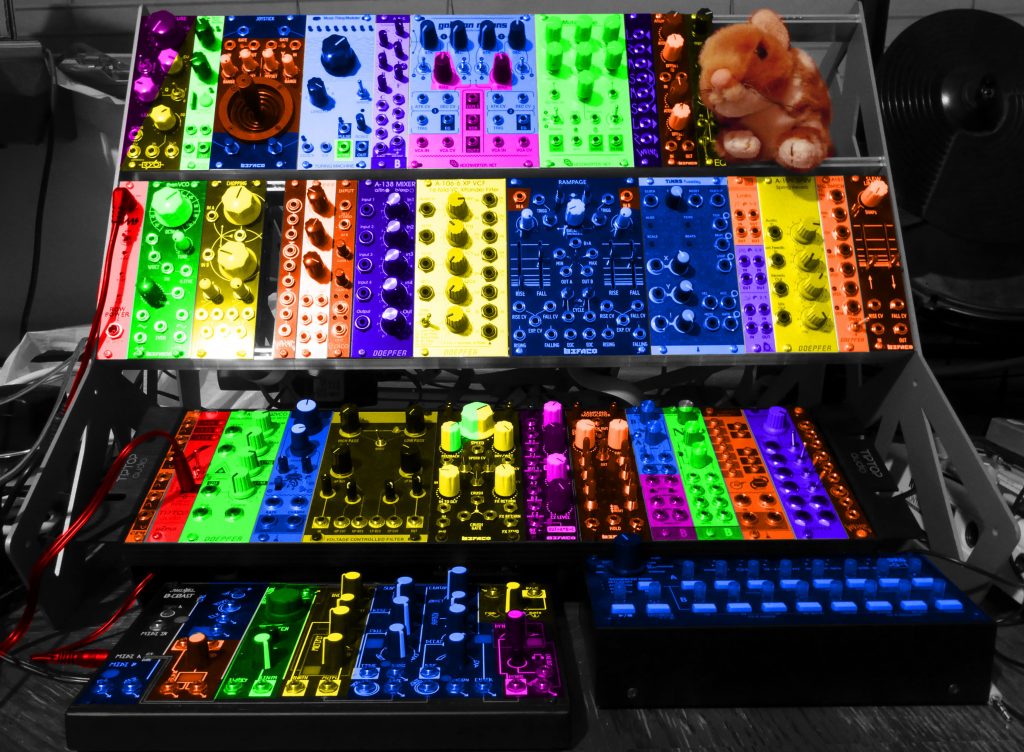
The multicoloured thing at the bottom left is a Make Noise 0-Coast synthesiser – it’s not a Eurorack module itself, but it can patch into and out of DASYRAC just fine. As you can see, it’s like a tiny self-contained modular system in and of itself. There’s also an ARP Odyssey floating around somewhere.
Everything starts with a supply of tasty electrons from two power supplies (in red). All the active modules connect to the two power supplies at the back by ribbon cable.
- Middle row: 4ms Row Power 30
- Bottom row: Tiptop uZeus
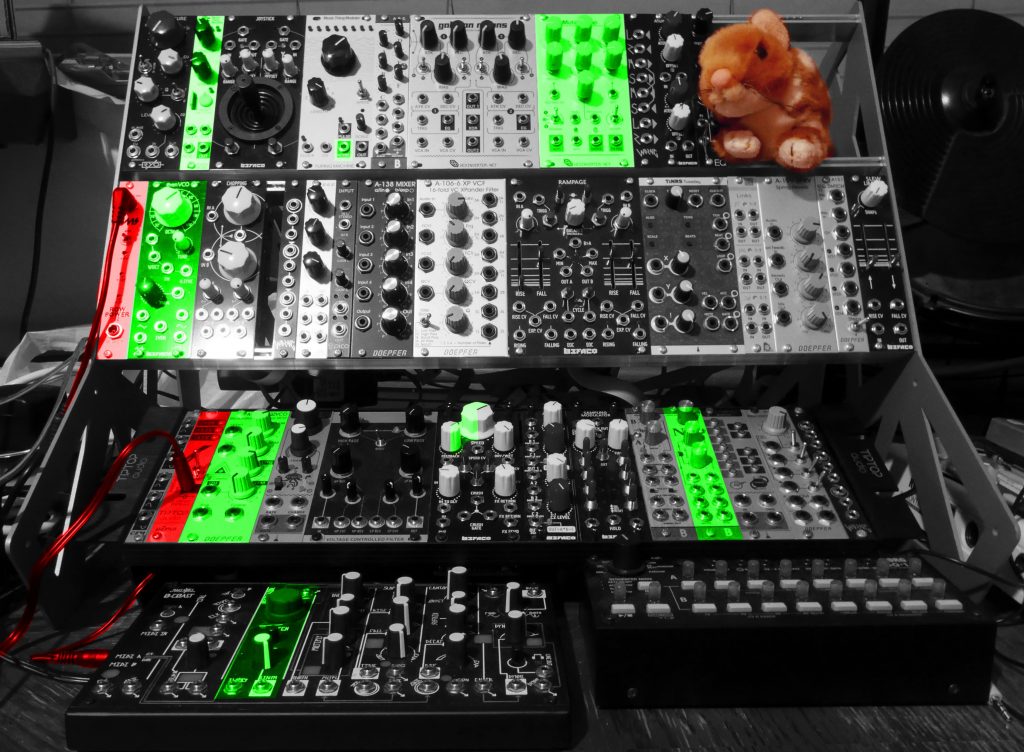
The green modules are audio sources. They speficially create oscillating voltages which are intended to be heard aloud at some point. Some are more fully featured than others – the green module in the centre top row is an entire self-contained instrument – it’s a recreation of the clap sound from a Roland TR-909. Audio sources which produce a musical tone – oscillators – have a 1V/Oct socket which takes a pitch voltage. The green module at the top left is a sound playback instrument.
- Top row: Music Thing Modular Radio Music (digital sample player); Music Thing Modular Turing Machine (noise source); Mutant Clap (TR-909 clap instrument)
- Middle row: Befaco Even VCO (saw-core analogue oscillator)
- Bottom row: Doepfer A-110-4 QZVCO (through-zero quadrature sine wave oscillator); Befaco Crush Delay (crackly lo-fi digital noise); Bastl Instruments Noise Squared (digital square oscillators and noise sources)
- Tabletop: Make Noise 0-Coast (triangle and square oscillator)
- Not shown: Korg ARP Odyssey (fixed-architecture synthesiser which can be run as a plain CV-controlled dual oscillator if need be)
The blue modules are “non-audio” voltage sources and include function generators like the Rampage, step sequencers like the SQ-1, procedural sequencers and clock sources like Tuesday, and random voltage generators like Turing Machine. Their job is to provide discrete or continuous voltages which can drive melodies, rhythms, filters, or whatever else accepts voltage control. If they’re running fast enough, voltage sources can also be used as oscillators in their own right.
- Top row: Befaco Joystick (gate source and fun voltage generator); Music Thing Modular Turing Machine (random voltage & trigger generator); Hexinverter Galilean Moons (two slope/attack-sustain-release generators)
- Middle row: Befaco Rampage (dual complex function generator); TINRS Tuesday (procedural phrase sequencer and clock source)
- Bottom row: Sonic Potions Mal-2 (random smooth voltage generator)
- Tabletop: Make Noise 0-Coast (MIDI-to-CV converter; low frequency oscillator source; clock generator; stepped random voltage generator; simple slope function generator; attack-decay-sustain-release envelope generator); Korg SQ-1 (simple sequencer)
- Not shown: Arturia Beatstep Pro (complex sequencer with 2 x gate, modulation and pitch channels, 16 x trigger channels, clock source, etc); Arturia Keystep (keyboard with gate, modulation and pitch out ); Korg ARP Odyssey (gate, trigger and pitch source)
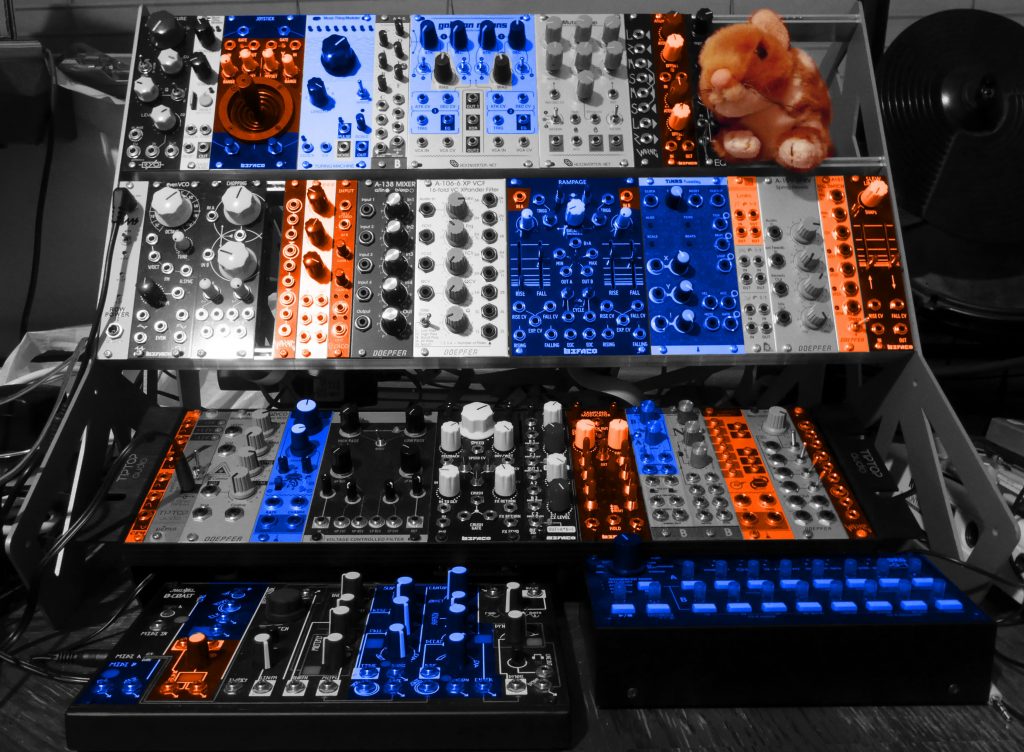
If the voltage sources put out voltages which aren’t quite right, that’s where the orange modules come into play. These modules are for manipulating voltages in different ways.
- Top row: Befaco Joystick (adds/subtracts incoming voltage); Befaco Dual Attenuverter (multiplies incoming voltage then offsets it)
- Middle row: Worng Electronics 3×3 mult (routes incoming voltage to multiple places); Thonk AT-AT-AT (triple signal attenuator to make things quieter); Befaco Rampage (turns gates into attack-sustain-release slopes); Erica Synths Pico Input (dual signal amplifier to make things louder); Mutable Instruments Links (makes exact copy of incoming voltage and sends to multiple destinations); Doepfer A-151 Sequence Switch (voltage controlled signal router); Befaco Slew Limiter (limits the rate of change of incoming voltage)
- Bottom row: CMF Half-Wave Rectifier (splits off positive and negative halves of incoming voltage); Befaco Sampling Modulator (samples and holds incoming voltage when triggered); Sonic Potions Penrose (quantises incoming voltage to equally tempered steps); Worng Electronics 3×3 mult
- Tabletop: Make Noise 0-Coast (signal attenuverter and summer)
The yellow modules are the effects and filters. Filters in particular make the incoming sound quieter at particular frequencies and also colour the sound in characteristic and desirable ways. They are “voltage controlled filters” (VCFs) because they take an input voltage to control their cutoff frequency, which is the frequency where the filters take effect. There’s also some effects modules for even more retro colour. Many of these modules can be made to create noises of their own without any input, which also makes them audio sources in their own right!
- Top row: RYO Aperture LPG (low pass gate, also usable as a VCA); Music Thing Modular Simple EQ (two-band EQ and EQ “tilter”)
- Middle row: Befaco Chopping Kinky (dual wavefolder); Doepfer A-106-6 XP VCF (state variable voltage controlled filter based on the Oberheim Xpander); Doepfer A-199 Spring Reverb (mechanical reverberation effect)
- Bottom row: Vintage Synth Lab VCF-74 (serial highpass and lowpass filter based on the Korg Minkorg 700s); Befaco Crush Delay (circuit-bent delay effect)
- Tabletop: Make Noise 0-Coast (integrated wavefolder and waveshaper)
- Not shown: Korg ARP Odyssey (switchable vintage low pass filter with CV cutoff control via the pedal input)
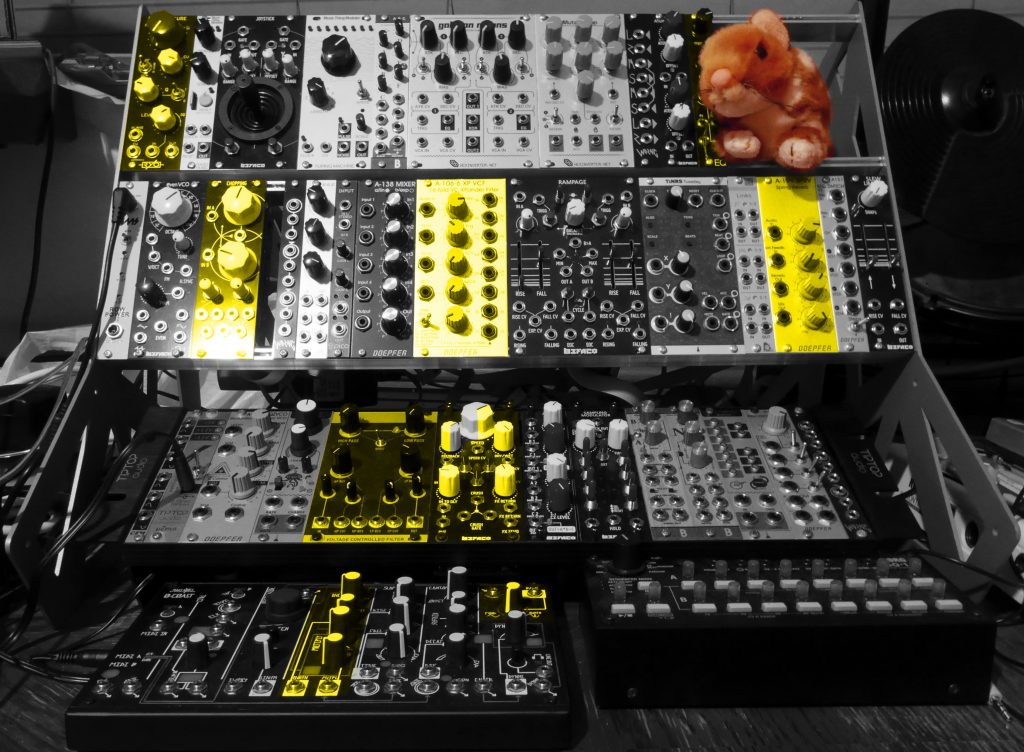
Violet modules are a special thing called VCAs – voltage controlled amplifiers/attenuators. A VCA takes two signals – an input and a modulating signal – and outputs a quieter/louder version of the input signal with amplitude/volume tracking the modulating signal. VCAs are where a long steady beeeeep sound is contoured into a short pip or a long mournful wail. Even better: a quadrature VCA can invert the incoming signal – chuck a sine wave into it as a modulator and you’ve got Dalek voices.
- Top row: RYO Aperture LPG (also usable as a VCF); Hexinverter Galilean Moons (with integrated envelope generator)
- Bottom row: Befaco A*B+C (dual full quadrature VCA with offset, also usable as a mixer); Bastl Instruments Skis (character VCA with integrated envelope generator)
- Tabletop: Make Noise 0-Coast (VCA stage including overdrive)
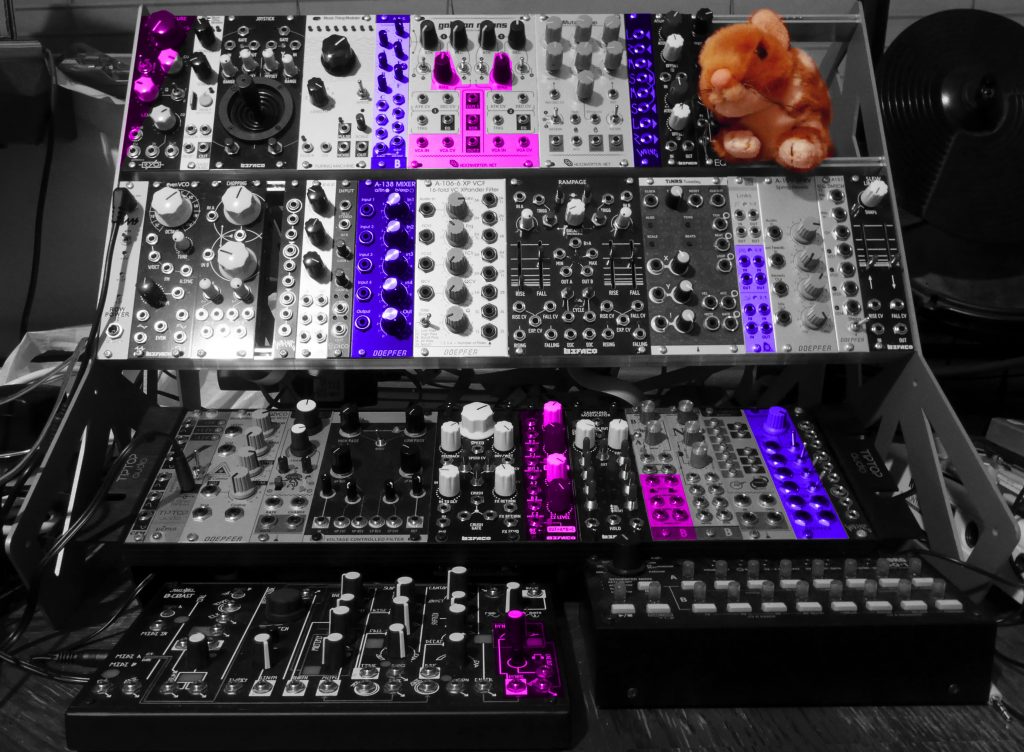
The last set of modules in indigo is for combining signals together. The modules can mix audio as well as control voltages.
- Top row: Bastl Instruments ABC (dual three channel mixer); Worng Electronics LRMSMSLR (left-right to mid-side encoder/decoder)
- Middle row: Doepfer A-138a linear mixer (four channel mixer with CV source on channel 1); Mutable Instruments Links (two channel unity gain mixer; three channel mixer)
- Bottom row: Doepfer A-185-2 Precision Adder (for combining pitch signals together, e.g. to transpose them)
Overall, DASYRAC is an eclectic system with features from the mainstream East Coast school (character filters, rich saw/pulse oscillators), the artier West Coast school (waveshapers, function generators, sequencers, low pass gates), old timey classics (spring reverb, shift register noise) and fun new possibilities (digital audio playback).
If you want to hear the sounds I’ve been making with it lately, check out my SoundCloud.
2 replies on “Introducing DASYRAC!”
Good grief you’ve been busy. Though you forgot to explain the role the plush quoll plays in all this.
The quoll is there to decorate the gaping void at the top right of the rack.